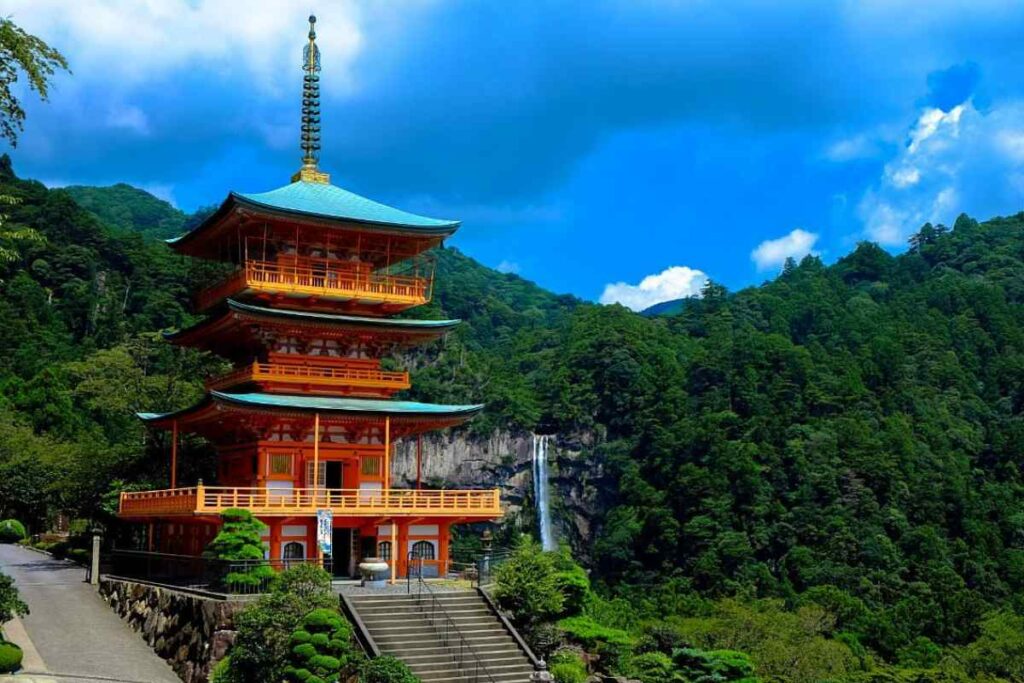Not only a word naming the dominant religion of Japan, Shintō is also a small village in the Japanese prefecture of Gunma.
There is a Dragon Ball Z character of the same name, and it is the spelling of a Javanese word for a Hindu goddess who is a protagonist in one of the most epic Hindu tales.

Word meanings (or Semantics) can be quite discombobulating.
Here, we will disambiguate the romanised term ‘Shintō’, explaining what the word means in as clear terms as possible.
Table of Contents
What is the origin of the word Shintō?
- Chinese Origin: Shéndào (神道) The Way of the Spirits or Spirit Path – Western Zhou Dynasty (1045-771 BCE).
- Shén – Spirit
- Dào – Path
Much of Japanese culture and tradition has roots in China. Shintoism is no exception to this. The term Shintō itseld, is a derivative of the Chinese word Shéndào.
Originating in ancient China, Shéndào is a specific philosophical approach to Religion.
This philosophy can be summarised as harmonising with Nature and entails moral teachings like any other religion does.
Key Fact: The Shintō religion was carried into Japan, purportedly, by tribal Korean invaders in prehistoric times.
What Does Shintō Mean?
Based upon its origins, the term Shintō translates into English as ‘The Way of Kami’.
The term ‘Kami’ is a Japanese translation of the Chinese word ‘Shén’, and ‘tō’ means ‘way’ similar to ‘Dào’. So, the term transcribes fully as ‘The Way of the Sprits’ or ‘The Way of the gods’.
Kami is considered to be a word symbolising many things:
- gods
- ancestral spirits
- spirits of nature
- forces like Good and Evil
- divinely sacred energies within both living and unliving entities.
What are the Variations of the Term Shintō?
There is a few variations of most words in the English Language.
Shintō is used as both a noun (naming word) and an adjective (describing word). As an adjective Shintō is used as what is known as a ‘prefix’ to many other words.
Once linked together, it creates a title of something linked to Shintoism.
Shintō also links to words like:
- Temple
- Shrine
- Ritual
- Festival
This list is but a few examples.
What Does Shintō Mean to the “Shintoist”?
To an individual following the religion, the word itself encapsulates everything under the umbrella of that religion.
It means that people are fundamentally good, whilst evil resides within influencing dark spirits or demons that can be cleansed via rituals and practices.
It means humanity is connected to and should live in harmony with Nature.
When Did Shintō Enter the Japanese Language?
Based upon its use, the term Shintō was romanised from Japanese (神道) in the late 18th century and its usage has grown exponentially from the 1900s to present day.
This coincides with the usage of the term Kami in Japan.
Shintō entered the Japanese language much earlier: reportedly in the 6th century when the Japanese decidedly wanted to separate Shintoism from the growing popularity of Buddhism.
Final Thoughts
To summarise, Shintō is the term which is an abbreviation of the noun Shintoism. It both names and describes the indigenous religion of Japan and means ‘The Way of the gods’.
Derived from a Chinese term and adapted for Japanese use, Shintō is now widely used and is recognised on a global scale. Although it was once a localised religion, it is now even practiced in parts of the world other than Asia.
- 12 Things Tourists Should NEVER Say in Japan
- Kissing Robot: Exploring the Popularity of the Chinese Kissing App
- Unlocking the Secret Dating Rituals Only Locals Know in Japan
- Samurai Armor: Ancient Protection for Japan’s Elite Warriors
- 10 Amazing Facts About Schools in Japan: Unique Traditions and Educational Practices
- Where can you see snow monkeys in Japan: Best locations and viewing tips









